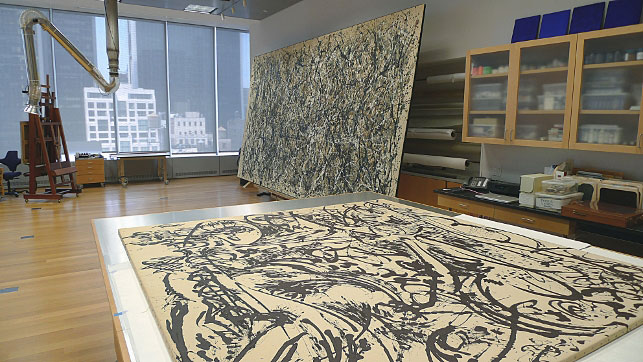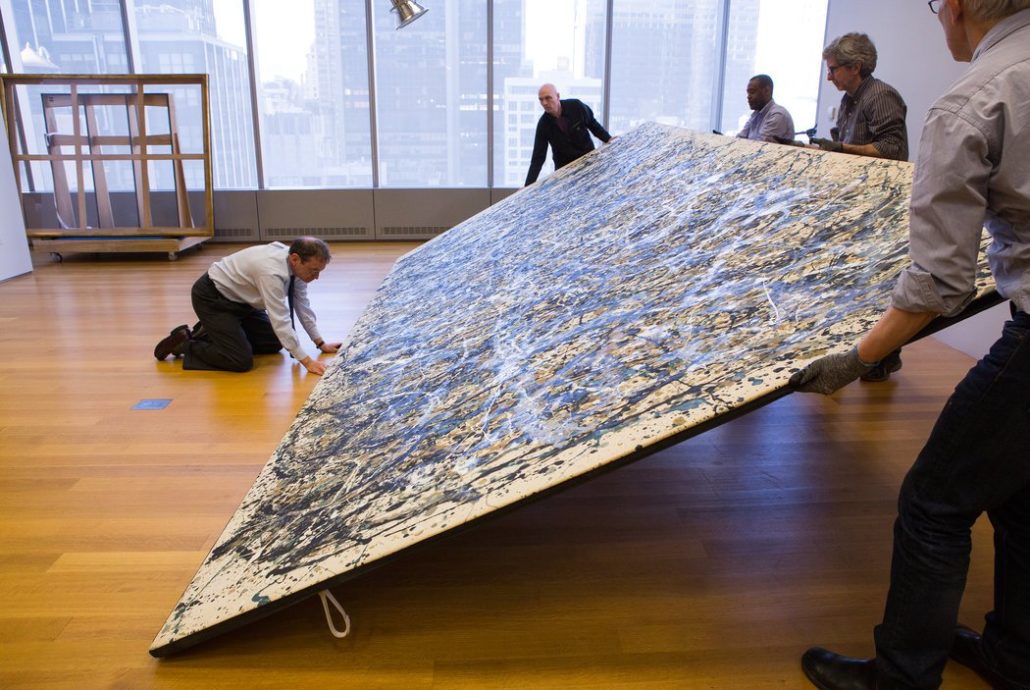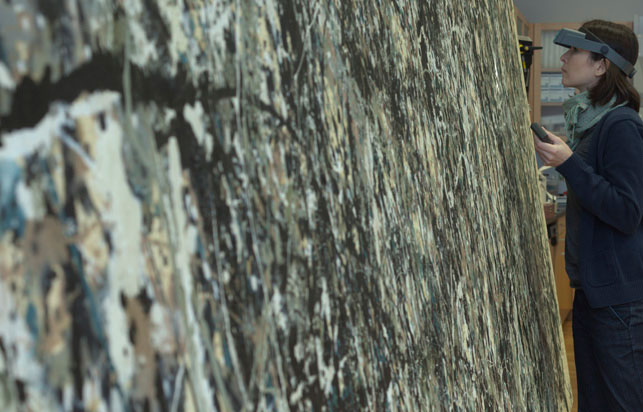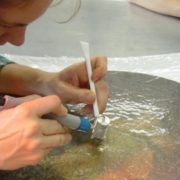Restoring Pollock: Making Modern New at MoMA and SAM
Einav Zamir

“One: Number 31, 1950” and “Echo” in the MoMA conservation lab. Courtesy: MoMA.
In the wake of extensive media coverage concerning a restoration purposed by the Seattle Art Museum of Jackson Pollock’s Sea Change, the 1947 groundbreaking work exploring the drip technique that would later define his career, it was brought to our attention that the Museum of Modern Art in New York is currently restoring their One: Number 31, 1950, a seminal piece in the museum’s collection.
Unlike SAM’s project, the cleaning has not received much mention in media outlets beyond the steady posts James Coddington, Chief Conservator, and his team have produced for MoMA’s blog, Inside/Out. The disparity of coverage between these two parallel events may have more to do with funding than the overall importance of the objects in question. While the Bank of America’s Art Conservation Project – an international program that offers grants to collections in order to restore works that are deemed in “danger of degeneration,” – is funding the project in Seattle, the backing for MoMA’s One: Number 31 is strictly an in-house, MOMA enterprise. Whether or not Sea Change is truly in danger of degeneration might be considered questionable – with the piece perhaps having been chosen as much for its high profile as its overall state of preservation. Certainly, no clear evidence of imminent disintegration has been produced. Whichever, the result of the grant will likely be two-fold. On the one hand, any alterations made to Sea Change will be highly publicized, and therefore open to scrutiny. On the other hand, there may be a greater temptation during treatment to produce a dramatic headline-worthy, high funds-justifying result, in which case a more drastic cleaning may follow.

James Coddington beginning conservation work on “One: Number 31, 1950”. Courtesy: NYTimes.
Conversely, MoMA’s project results from their 1998 Pollock retrospective, which was the first time One: Number 31 was displayed alongside an extensive body of material housed in various collections. The exercise showed that these paintings were in varying states of preservation. In particular, Pollock’s Echo: Number 25, 1951, according to Coddington, had yellowed considerably from its original state, and was in need of cleaning. However, what makes the restorations of Sea Change and One: Number 31 worth studying, beyond the various differences in approach that are bound to appear in the coming months, is the issue of re-touching. Concerning Sea Change, Art Daily reports that “the conservation treatment focuses on removing the later restoration in order to recover a surface that more closely reflects Pollock’s original technique and intent.” In doing so, the team from Seattle plans to strip the varnish applied by a conservator in 1970. Similarly, the MoMA conservation team determined that several areas of One: Number 31 contained traces of compositionally dissimilar paint, added at a later point to cover cracks that had appeared in the surface. One: Number 31 was evidently retouched sometime in the mid-60s, prior to its arrival at MoMA in 1968. Whether these areas should be removed at all is debatable. If we are to assume that the retouching had been carried out during a previous restoration, then their removal could be seen as a way by which Coddington can undo the mistakes of former practitioners. However, if these re-touchings were done by some other party, either connected to Pollock himself or one of the previous owners, then we must consider whether or not these additions have become part of the history of the piece itself, and that in removing them, we lose something of this history.

Jennifer Hickey, Project Assistant Conservator, examining “One: Number 31, 1950”. Courtesy: MoMA.
In short, as these areas are removed and the restorations of One: Number 31 and Sea Change continue, we are forced to take another look at established classics. Perhaps this second look will bring us closer to Pollock’s original vision, though we may possibly find ourselves further away from what he and his work have come to be.
For more information regarding MoMA’s restoration process, please visit: http://www.moma.org/explore/











Leave a Reply
Want to join the discussion?Feel free to contribute!